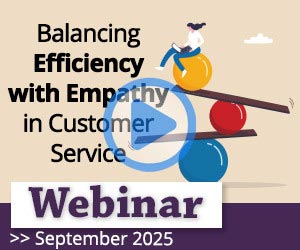We share lots of examples of how to better upskill advisors in the contact centre.
1. Recognize the Benefits
The first question that you need to answer is: what’s in it for the team to learn this new skill?
Many advisors can be hesitant to learn additional skills because they don’t understand how it will positively impact them, their colleagues or customers.
So, before your start upskilling, highlight the benefits and continue to reinforce them as you move along the process.
Tell the advisor: “Just imagine if you could do X how much easier that would make Y.”
Statements like this give the advisor a purpose. This can be incredibly motivational when learning new skills.
2. Give Advisors Belief That They Can Do It
Nick Drake-Knight, founder of Continue and Begin, came up with the concept of a “tissue-paper prison”.
He believes that we often fail to realize our potential because, as soon as we start to find something difficult, we immediately think that we cannot achieve it. This is a limiting belief.
In other words, we put ourselves into a “tissue-paper prison”.
When upskilling advisors, we need to instil them with the confidence and belief to step outside of their tissue-paper prison.
So motivate advisors with a positive future feeling, and if an advisor ever says: “I can’t do that”, challenge them. Kickstart a conversation about how they can overcome their limiting belief.
3. Use Coaching Models
When looking to coach in new skills, there are a few coaching models that you can fall back on.
For starters, you can use the GROW model to help advisors spot their own performance improvement opportunities.
To use this model, ask advisors each of the following questions:
- Goal – What do you want?
- Reality – Where are you now?
- Options – What could you do?
- Will – What will you do?
These questions will help your advisors get to a stage of self-realization, so you are not just telling the team what to do.
Other good models that you can use in the contact centre to help upskill your team include the “Two Stars and a Wish” and the “Think” model.
To find out more about how to best use these models to train advisors, read our article: Contact Centre Coaching Models: Which Is Best for Your Coaching Sessions?
4. Train to Different Learning Styles
If you know how an advisor learns best, you can tailor coaching and support material to match the advisor’s preference. This will speed up the upskilling process.

“Planning different activities and methodologies with your training programmes is key, and if you have classroom training for a large group of people, make sure there is something in there for every learning style,” says Marie Cross, a Training Director at First Impression Training.
One model that you can use to help you here is the VARK model, where each individual letter stands for a different type of learner:
- Visual Learners – Learn best through maps, flowcharts and graphs
- Auditory Learners – Learn best through group discussions, lectures and podcasts
- Read and Write Learners – Learn best through quotations, lists and PowerPoint presentations
- Kinaesthetic Learners – Learn best through role-playing, simulation and examples
By creating content for each of these four types of learner, you can better support your advisors and also provide a much more enjoyable upskilling experience.
5. Develop Personal Development Plans
Sit down with individual advisors and create a plan for how they will become “unconsciously competent” in using their new skill – i.e. so it comes naturally and they don’t have to think about it.
This starts by setting goals, prioritizing them and agreeing deadlines for when the advisor will achieve key outcomes.
Think about what the advisor’s learning style and discuss what they can do to meet these goals in the timeframe. Make sure advisors are motivated by the prospect of gaining the new skill.
Finally, ask the advisor to make a written commitment. By committing to doing something, research shows that we are much more likely to see it through.
6. Include Visuals in All of Your Support Material
By adding visuals to your training materials, you can better engage visual learners and increase the likelihood that they will recall all the necessary information.
Simple hand sketches can do the trick, as – when it comes to learning – it is best to keep everything as simple as possible.
Visual guides and flowcharts are also great for encouraging advisors to learn processes, while graphs and diagrams will be better suited to highlight important bits of information.
So, rework your company training manuals. Add colour and vibrancy, and bring your black-and-white text to life with various types of engaging imagery.
7. Chunk Up the Learning
Don’t cram lots of information into a long coaching session and expect advisors to pick up the new skills right away.
Instead, give the advisor some time to process the information and then add in follow-ups. These follow-ups will encourage advisors to “relearn” the skill.
When we leave gaps between sessions and continuously reteach a skill – through a range of different techniques, like video, e-learning and quizzes – we create a pattern of forgetting and relearning.
While it may seem counter-intuitive, this pattern is what strengthens memory over time.
8. Listen to Great Call Recordings
Upskilling advisors can involve the team having to learn lots of new concepts. Some of these can seem quite abstract.
By sharing examples of call recordings where another advisor applies such a concept to a call, you can better ensure that the listener takes away concrete learning from a coaching session.
Transcripts can also be good when coaching advisors to handle digital channels like email, live chat and social, while screen recordings can be even better. This ensures that the advisor sees the entire process.
9. Make Time for Observed Learning
Observed learning is a contact centre tool that would traditionally involve sitting next to an advisor as they take calls, discussing what they did well and how they can improve.
This can be very useful in coaching a new skill and building confidence, as the coach can observe body language and how the advisor navigates different systems and performs “in the moment”.
While this is tricky in a remote setting, you can create a virtual side-by-side strategy and also utilize screen recordings – alongside call recordings – to gain a clear picture of advisor performance.
10. Create Bite-Size Video Training Sessions
Create a series of bite-size video training sessions that look at a specific subject.
For example, if you were looking at the topic of handling difficult conversations, you could create quick video guides on:
- How to say “no” to a customer
- How to calm down an angry customer
- How to handle a request for an escalation
“These videos should be no longer than three to five minutes, as that is the average attention span of someone who is online,” says Marie.
“Then, and the end of the video, look for a way for the advisor to contextualize that into their own specific environment.”
This is easy in the physical contact centre, as you could just do some at-desk training. However, you can still do role-plays in a remote environment…
11. Reinforce Learning With Role-Plays
When an advisor is struggling to incorporate new skills into their performance, customer service role-plays can be a really great way to practise within a safe environment.
“Have the advisor role-play the customer and do all the things that they need coaching on so they can see from the customer’s side,” recommends Erica, one of our readers.
By gaining the customer’s perspective, not only will the advisor learn how to navigate tricky contact types, but they will also gain a sense of the thought processes and feelings of the customer.
Such an experience helps advisors to put themselves into the customer’s shoes.
For more on getting the most out of this coaching technique, read our article: 9 Customer Service Role-Plays
12. Lunch-and-Learn Sessions
You want coaching to be as memorable as possible. This will ensure that it has a lasting impact.
Lunch-and-learn sessions help to serve this purpose by mixing things up.
With sessions not being viewed as “overly formal”, lunch-and-learns give advisors the opportunity to let their guard down and be more open in sharing knowledge.
Of course, by providing food, there may be some costs involved. However, this is outweighed by making a more productive use of break times.
13. Online Masterclasses
Masterclasses are often between 60 and 90 minutes long and they are great for going into good depth on a topic.
However, as Marie says: “It cannot be an hour-long lecture. You’ve got to mix it up to keep people engaged, just as you would in a classroom.”
Start by chunking up your presentation into ten-minute segments, looking for audience interaction in between.
Also, you can use video-conferencing tools to create polls, ask open questions in the chat function and open up breakout rooms. These give advisors the opportunity to put what they have learned into practice.
14. Reflective Exercises
Sometimes looking back over an experience and trying to recall information, without any help from training materials, can help us to learn much more effectively.
Asking advisors to reflect on calls in which they were able to use the new skill well – or maybe even a role-play scenario – helps to break down the experience into its most significant aspects.
Thinking this through in a one-to-one session will help to create a link between general learning and more significant actions that the advisor can replicate in the future.
By developing a series of reflective exercises, you can maximize the value of any learning experience.
For a series of exercises that are designed to improve your customer service, read our article: 9 Fun Customer Service Training Exercises
15. Peer Reviews
Having advisors listen to one another’s calls and give feedback can be a great way to encourage positive learning conversations which accelerate the upskilling process.
Not only that, peer-to-peer coaching helps your team to stay connected – which can be important in remote contact centres – and lightens the workload of your coaches and leaders.
The danger of this upskilling method is that the advisor must be trained to coach fairly in the first place, otherwise the practices being shared may not be helpful in improving customer service.
Get this right, however, and you can create an invaluable learning culture within your contact centre.
16. Encourage Self-Learning
Online self-learning is a great way for advisors to continue learning between contacts.
If calls are coming in slower than anticipated, you can encourage advisors to use your online learning system to complete certain modules related to the new skill.
Within many performance management tools, you can even build modules yourself to personalize learning to the individual. This massively boosts its value.
You can also use the system to develop your own quizzes, track advisor progress and maybe even create some games…
17. Game-Based Learning
Whether you devise games especially or invest in a gamification system, it can all help to make upskilling a more engaging process.
Also, as our reader Hannah suggests: “Don’t be afraid to disclose your business objectives/reasoning behind a gamification initiative, otherwise you risk getting lower engagement.”
This is a key point, as you want to align the fun, positive experience with the learning opportunity, so it becomes more memorable and, therefore, more likely to stick.
Discover some fun contact centre games, which can be tailored to meet your upskilling needs, in our article: The Best Motivational Games for Employees and Remote Workers
18. Set Challenges
Upskilling can feel like a lot of learning. Setting short-term challenges, so that advisors feel like they are constantly making progress, makes the process seem much easier.
Challenges can also help advisors to align their focus and build their confidence in meeting even bigger achievements down the line.
Creating these goals is also useful in giving advisors a sense of clarity into exactly what they need to do to improve.
Just make sure that you give feedback on every goal, so it stays relevant, and make adjustments if needs be.
19. Buddy With an Expert
Many contact centres have subject-matter experts (SMEs). These are advisors who are especially knowledgeable in one particular skill or in handling a certain situation.
When an advisor needs support in learning a skill in which an SME specializes, they should be on hand to provide support – whether that’s face-to-face or via a designated Slack channel.
In fact, a buddy or mentoring system between the SMEs and the advisor can work wonders in helping the advisor to quickly get up to speed with their new skill.
20. Schedule Follow-Ups
A key takeaway is to mix up your methods for upskilling, including virtual classrooms, simulations and reflective learning – as just some examples.
But don’t stop there. Once you are satisfied that the advisor is fully competent at using their new skill, make sure that you follow up with targeted quality monitoring.
By doing so, you can be sure that the upskilling process has worked as planned and that the advisor is fully confident in what they are now doing.
In this video, Marie Cross shares ‘The Tape Technique’ to deliver bad news.
For more on developing skills in the contact centre, read our articles:
- Customer Service Skills: How to Improve Empathy, Active Listening and Knowledge
- 20 Expert Ideas to Improve Your Customer Service Skills
- The Top 10 Most Important Customer Service Skills
Author: Robyn Coppell
Reviewed by: Hannah Swankie
Published On: 2nd Jun 2021 - Last modified: 6th Oct 2025
Read more about - Customer Service Strategy, Editor's Picks, Multi-Skilling, Service Strategy, Soft Skills, Training and Coaching







































